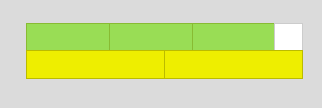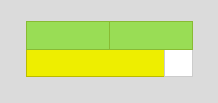Skip over navigation


Give students some time to explore, and then challenge students to look for general patterns in their results. One very fruitful line of enquiry, which leads to generalisations that might involve triangular numbers, is suggested in the problem:
Some students might use algebra to justify the patterns they notice.
Another line of enquiry might be to consider how to generate other arrangements from a particular example.
For example:
How can you tell whether it will be possible to make a difference of 1 for a particular pair of rods?
If you record your results in a systematic way, what patterns can you see? Can you prove that they will continue?

Or search by topic
Number and algebra
Geometry and measure
Probability and statistics
Working mathematically
Advanced mathematics
For younger learners
Different by One
Age 14 to 16
Challenge Level 





- Problem
- Getting Started
- Student Solutions
- Teachers' Resources
Why do this problem?
This problem presents a context in which students can work systematically, notice surprising patterns, and make generalisations that they can explain visually, numerically or algebraically.Possible approach
Students could use Cuisenaire rods to work on this challenge, or the online Cuisenaire environment, or squared paper if rods are not available. Introduce the problem: invite students to choose two different colours of rod and make a line of each colour so that the lengths differ by the length of one white rod. You might like to show them the examples using yellow and green:

Give students some time to explore, and then challenge students to look for general patterns in their results. One very fruitful line of enquiry, which leads to generalisations that might involve triangular numbers, is suggested in the problem:
- If you start with two rods that differ in length by 2, when is it possible to make two lines that differ by 1?
- How many of each rod will you need?
Some students might use algebra to justify the patterns they notice.
Another line of enquiry might be to consider how to generate other arrangements from a particular example.
For example:
2 greens is longer by 1 than 1 yellow
7 greens is longer by 1 than 4 yellows
12 greens is longer by 1 than 7 yellows
7 greens is longer by 1 than 4 yellows
12 greens is longer by 1 than 7 yellows
Key questions
Using red (2) and pink (4), you can never make a difference of 1 - why not?How can you tell whether it will be possible to make a difference of 1 for a particular pair of rods?
If you record your results in a systematic way, what patterns can you see? Can you prove that they will continue?
Possible support
Encourage students to start by investigatingpink (4) and dark green (6)
yellow (5) and black (7)
dark green (6) and brown (8)
black (7) and blue (9)
For each pair, they could work systematically until they either find a combination that has a difference of one or have a convincing argument why it is impossible.yellow (5) and black (7)
dark green (6) and brown (8)
black (7) and blue (9)
Possible extension
Students could explore pairs of rods that can be arranged into lines whose lengths differ by two, three, four...You may also like
DOTS Division
Take any pair of two digit numbers x=ab and y=cd where, without loss of generality, ab > cd . Form two 4 digit numbers r=abcd and s=cdab and calculate: {r^2 - s^2} /{x^2 - y^2}.

